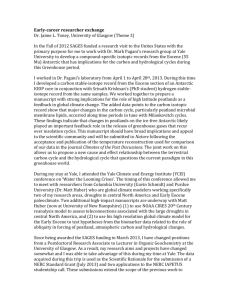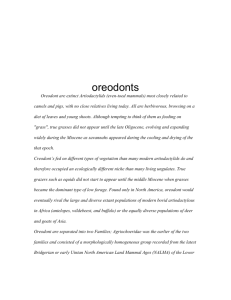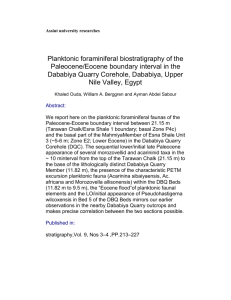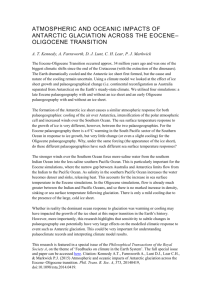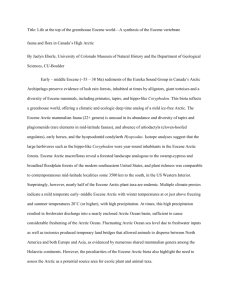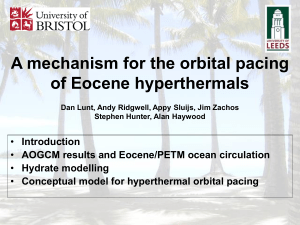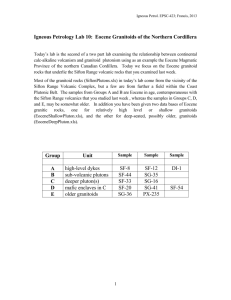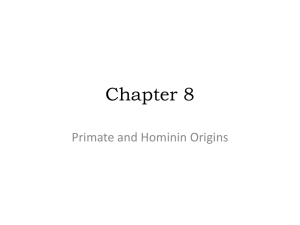NANGULLAN TECTONOSTRATIGRAPHIC SETTING
advertisement
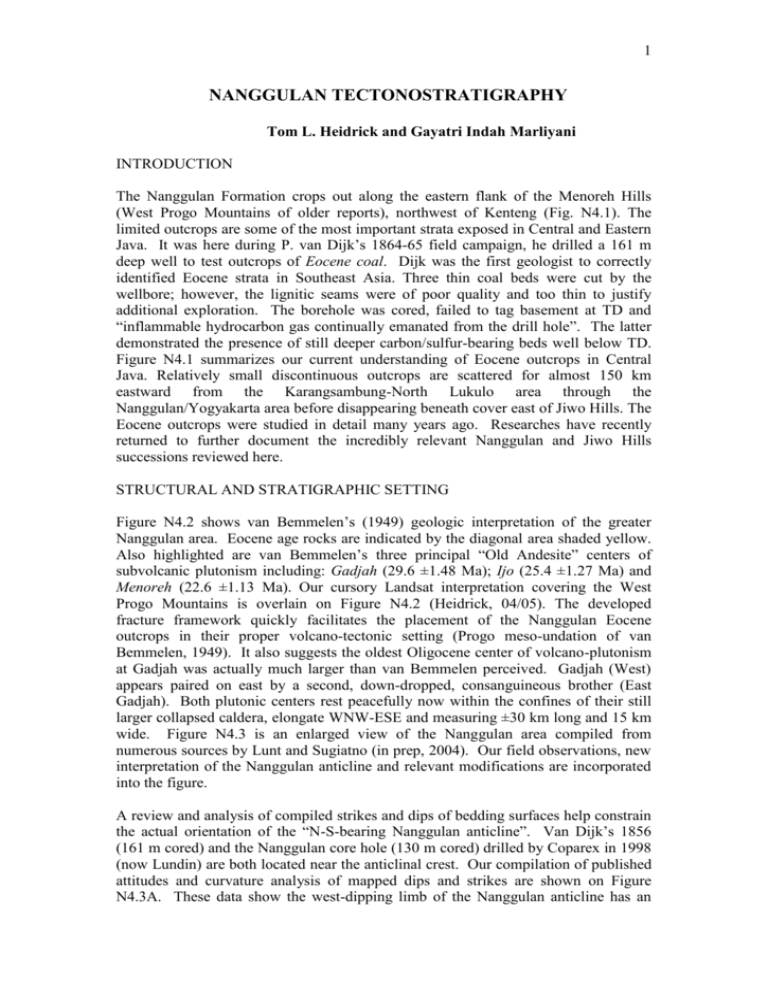
1 NANGGULAN TECTONOSTRATIGRAPHY Tom L. Heidrick and Gayatri Indah Marliyani INTRODUCTION The Nanggulan Formation crops out along the eastern flank of the Menoreh Hills (West Progo Mountains of older reports), northwest of Kenteng (Fig. N4.1). The limited outcrops are some of the most important strata exposed in Central and Eastern Java. It was here during P. van Dijk’s 1864-65 field campaign, he drilled a 161 m deep well to test outcrops of Eocene coal. Dijk was the first geologist to correctly identified Eocene strata in Southeast Asia. Three thin coal beds were cut by the wellbore; however, the lignitic seams were of poor quality and too thin to justify additional exploration. The borehole was cored, failed to tag basement at TD and “inflammable hydrocarbon gas continually emanated from the drill hole”. The latter demonstrated the presence of still deeper carbon/sulfur-bearing beds well below TD. Figure N4.1 summarizes our current understanding of Eocene outcrops in Central Java. Relatively small discontinuous outcrops are scattered for almost 150 km eastward from the Karangsambung-North Lukulo area through the Nanggulan/Yogyakarta area before disappearing beneath cover east of Jiwo Hills. The Eocene outcrops were studied in detail many years ago. Researches have recently returned to further document the incredibly relevant Nanggulan and Jiwo Hills successions reviewed here. STRUCTURAL AND STRATIGRAPHIC SETTING Figure N4.2 shows van Bemmelen’s (1949) geologic interpretation of the greater Nanggulan area. Eocene age rocks are indicated by the diagonal area shaded yellow. Also highlighted are van Bemmelen’s three principal “Old Andesite” centers of subvolcanic plutonism including: Gadjah (29.6 ±1.48 Ma); Ijo (25.4 ±1.27 Ma) and Menoreh (22.6 ±1.13 Ma). Our cursory Landsat interpretation covering the West Progo Mountains is overlain on Figure N4.2 (Heidrick, 04/05). The developed fracture framework quickly facilitates the placement of the Nanggulan Eocene outcrops in their proper volcano-tectonic setting (Progo meso-undation of van Bemmelen, 1949). It also suggests the oldest Oligocene center of volcano-plutonism at Gadjah was actually much larger than van Bemmelen perceived. Gadjah (West) appears paired on east by a second, down-dropped, consanguineous brother (East Gadjah). Both plutonic centers rest peacefully now within the confines of their still larger collapsed caldera, elongate WNW-ESE and measuring ±30 km long and 15 km wide. Figure N4.3 is an enlarged view of the Nanggulan area compiled from numerous sources by Lunt and Sugiatno (in prep, 2004). Our field observations, new interpretation of the Nanggulan anticline and relevant modifications are incorporated into the figure. A review and analysis of compiled strikes and dips of bedding surfaces help constrain the actual orientation of the “N-S-bearing Nanggulan anticline”. Van Dijk’s 1856 (161 m cored) and the Nanggulan core hole (130 m cored) drilled by Coparex in 1998 (now Lundin) are both located near the anticlinal crest. Our compilation of published attitudes and curvature analysis of mapped dips and strikes are shown on Figure N4.3A. These data show the west-dipping limb of the Nanggulan anticline has an 2 average orientation of 186º, 15.5º; whereas, the average orientation of the westdipping limb is 025º, 27.5º. These averaged attitudes suggest a mean Nanggulan crestal axis of 205º, 08º. In an attempt to determine the true thickness of drilled and exposed Eocene strata at Nanggulan, cross-section A-A’ was constructed accepting the following parameters: a) a cylindrical fold geometry; b) the fold was generated about an axis bearing 205º, 00º; c) Busk construction methodology is applicable, and d) a true thickness of 161 m of Eocene was penetrated in Dijk’s borehole. This thickness seems likely since mapped faults are few and “the dip of beds in the drill hole was small…with a dip of 12º at 100 m. depth” (Dijk, 1865). Figure N4.3A shows the location of cross-section A-A’ and provides details of its structural and stratigraphic setting. Correcting for the topographic relief along profile A-A’, and measuring perpendicular to the Busk dip domains, the total thickness of penetrated and exposed Eocene at Nanggulan is ± 711 m. This is thicker than the 500-550m commonly mentioned by previous authors. In an attempt to close the difference, all dips and strikes mapped from Eocene outcrops in the Nanggulan area were plotted using Rockware’s Schmidt lower hemisphere projection software. This analysis predicts the Nanggulan anticline plunges 203º, 03º. Figure N4.4B shows the results of both approaches. The minor difference in plunge (08º vs. 03º) has little net affect on the reconstructed stratal thickness; moreover, the 203º bearing would produce a thicker section not thinner. An effective way of reducing the Busk constructed stratal thickness is to assume the west dipping flank of the Nanggulan anticline actually dips on average less than 15.5º. Geometrical details of the Nanggulan anticline and stratal relationship with the adjoining footwall Menoreh volcanics is provided by van Bemmelen’s Figure 299 drawn normal to the anticline and parallel to profile A-A’ (van Bemmelen, 1949). His cross-section is included as an inset C on Figure N4.5. The section depicts an open, upright, west-facing asymmetric anticline with “Eocene Nanggulan” strata dipping up to 45º and 30º on west and east respective limbs. The younger “rigid heavy breccias of G. Mudjil” are drawn with a slight unconformable relationship upon the Nanggulan. It is relevant to note the geometry portrayed conforms closely to those produced using the Busk methodology. Liberty was taken to assume this construction methodology and his lowermost Nanggulan strata were reconstructed using Busk dip domain radii at P1 and P2. Strata are continued westward in their down-dip direction to the normal P3-P4 drawn from youngest outcropping strata to lowest strata shown on inset C, Figure N4.5C. The reconstructed thickness shown by van Bemmelen is ±686 m. This thickness was determined later and independent of the 711m determined and discussed here. Both thickness are within the limits of construction error and suggest an averaged thickness of “±699m” for the exposed Middle and Late Eocene Nanggulan section. A maximum dip of 25º is predicted by the Busk methodology for the west-dipping limb. This is in marked contrast to the 45º indicated on van Bemmelen’s (Fig. N4.5C). In order to further confirm employed geometry and dip distributions, an additional day of field work was added to the program. Seven (7) additional attitudes from the Middle Eocene Nanggulan section were taken, added to the original compiled attitudes (13) and re-plotted using the Rockware software (Fig N4.4B). Attitudes gathered by the EJBON field team were collected from both limbs of the anticline, 3 show a much wider geologically reasonable variance in both strike and dip, as well as, reveal a maximum 25º dip, bearing 310. The resultant attitude of the Nanggulan crestal line using all 20 poles to planes is 200º, 00º. This is added and shown along with the two earlier solutions on Figure N4.4B. An effective penetrated and exposed Middle Eocene stratal thickness of ±700 m is recommended for the west flank of the Nanggulan anticline. No dips approaching the suggested 45º were recognized by the EJBON field teams. We were likewise unsuccessful in establishing the 30º eastdipping Nanggulan beds indicated in van Bemmelen’s cross-section. The average EJBON east-dipping limb is only 145º, 17º although foreset beds were observed dipping up to 23º. The contrasting east-facing asymmetry for the Nanggulan fold depicted on Figure N4.4A follows original assumptions using all available mapped attitudes within the Nanggulan area. A 127º, 45º dip is recorded at the East Songo 3&4 sample location and its inclusion influences the Busk constructed, asymmetric Edipping limb geometry. Its inclusion does not alter the thickness predicted from the west-facing flank construction. This dip is suspect and needs confirmed by more detailed field work or is correct but reflects a local mesoscopic drag fold. E0CENE AND OLIGOCENE NANGGULAN STRATIGRAPHY Figure N4.4 summarizes the lithostratigraphic and time stratigraphic character of the three major sedimentological sequences proposed by Oppenoorth and Gerth (1929, “1e, 2e, and 3e”). Each of the three principal Middle Eocene cycles and condensed Oligocene units are discussed sequentially from base drilled section penetrated in Dijk’s Nanggulan wellbore to base Menoreh volcanics. In the following timestratigraphic framework, it seems wise to retain the original Middle Eocene Nanggulan nomenclature. By raising the Nanggulan to Group status the major stratal sequences first identified and described by Oppenoorth and Gerth including Te1-3, become equivalent to formations. The Oligocene Nanggulan terminology should be changed, raised to formation status and given a different name. It is retained here however and symbolized as Ton. Lower Nanggulan Formation (Te1) The lowest sequence of Nanggulan strata (Te1) is ±381 m thick as constructed on cross-section A-A’ or a minimum of 316 m drilled and measured. The lower “a” member (Te1a) represents the 161m penetrated in Dijk’s Nanggulan well plus an additional 28 m of overlying carbonaceous mudstone and muddy sandstone as reflected on Figures N4.4A and N4.6. Figure N4.5 also compares the Gamma ray log ran by Coparex (1998) in their twinned drill hole. Member “a” is dominated by a thick succession of “carbonaceous clay with brown coal laminae” intercalated with “fine yellowish grey mudstone and carboniferous slate (shale) layers” (van Dijk, 1865). Persistent brown, high-sulfur lignitic coal beds measuring from 10-25 cm in thickness were encountered by Dijk scattered through out the lower member. Interbeds of sandstone, claystone, siltstone and dark carbonaceous shale are intercalated with the coal seams. These lithologic characteristics combine with the presence of trough and ripple cross-bedding, local interbeds of conglomerate and ubiquitous carbonaceous material suggest swamp-like conditions. Brackish mangrove swamps isolated on an aggrading fluvio-deltaic plain seem an appropriate setting for the lower Te1a Member. Intermittent shallow marine conditions are indicated by Dijk’s casual reference to “nummulids” (Nummulities djokdjakartae) and Assilina 4 depressa within the “a” succession. Refer to the attached montage of several important large and small foraminifera found at Nanggulan (N4.8). An increase in marine influence is noted a few meters above Dijk’s cored interval and most likely reflects the presence of a third order sequence boundary. The upper “b” member of Te1 consists of grey claystone/mudstone intercalated with porous quartzand ±feldspar-rich sandstone interbeds and laminae. Figure N4.4A(B) shows the member as ± 192 m thick. Gayatri Indah has measured several stratigraphic sections and estimates a composite thickness of 155m without tying the lowest section to the drilled “crestal axis”. A Te1b thickness of ±155m is considered an acceptable match to the independently reconstructed Busk thickness measurement of 192m. Fossils contained within the claystone layers include an abundance of the mollusc Axinaea dunkeri and thin foraminifera-rich layers of Nummulities djokdjakartae and Discocyclina. Sand size material is dominated by clear unstrained, angular to subangular quartz grains and a maximum of 15-20% occluded debris from a weathered meta-quartzite and argillite basement terrane. Sands are often poorly consolidated although dolomitic and sideritic cements are observed. Minor pyritic carbonaceous siltstone and coal laminae are found near the base of the upper unit but give way upward as more marine conditions prevail. The Te1b Member is interpreted as a highstand sequence with a transgressive top. Te1 is entirely Middle Eocene (P11-12) spanning an estimated 3 to 4 Ma. The calculated limits for the accumulation rate using the Busk thickness (381m) is 95-127 m/Ma. Accepting the a minimal thickness of 155m Te1b produces an average compacted accumulation rate varying between 86-115 m/Ma over 1.5 and 2.0 Ma cycle durations. A range of 86-127m/Ma is rapid but is believed representative for deposits of the lowest transgressive systems tract. Middle Nanggulan Formation (Te2) Member Te2 is entirely exposed in outcrop in the Nanggulan area (Figs. N4.3, A-A’; and N4.6). The constructed thickness shown on cross-section A-A’ is 210 m (Fig. N4.4A). Purnamaningsih (1973) quotes a measured thickness of 155m. The unit as a whole displays a mixture of dark grey, green and brown claystone, arkose and tuffaceous sandstone. The basal and lower portion of the unit is dominated by an intercalated succession of arkosic, andesitic and tuffaceous sandstone and calcareous/tuffaceous claystone. There is a complete absence of carbonaceous material, trough and ripple cross-bedding, conglomerate, mollusca and pyritic coals. Deep marine turbiditic conditions are supported by the occurrence of radiolarian debris accompanied by bioclasts including abundant Discocyclina and less common Nummulites. The thick Discocyclina/Asterocyclina beds (up to 5 cm) noted by Oppenoorth at Watupuru are believed similar to those found in the Gamping area of east Jiwo Hills. Thin planktonic-rich marl, chalk and claystone increase in quantity upward concurrent with a decrease in the frequency of included volcanic material. The increase in carbonate content upwards is diagnostic along with the ubiquitous appearance of allochthonous bioclasts containing Discocylina, Asterocyclina and scattered planktonic forams. The base of member Te2 is considered a sequence boundary resting on an a weakly degraded, disconformable Te1b surface overlain by a 155- 210 m thick transgressive 5 systems tract of Middle Eocene (midP12-13) age. The suggested Te2 systems tract lasted for 1.4 Ma yielding rates for compacted sediment accumulation between 111150 m/Ma. This rate is comparable with the estimated rate of the upper Te1b member. Although sediment flux rates are similar, the nature and abundance of occluded volcaniclastic material in member Te2 is distinctly different than the siliceous volcanic providence suggested for the siliciclastic material observed in Te1b. The eruptive center for the proximal andesitic sandstones, lapilli tuff (up to 1m thick at Kali Watupuru) and crystal-lithic tuffs (Pundak River) are not known but almost certainly are from areas near the Nanggulan area. The altered porphyritic andesite and dark grey andesite clasts collected from the Sangiran mud volcanoes are potential candidates for this oldest Paleogene (Middle Eocene) volcano-plutonic activity in Java. Upper Nanggulan Formation (Te3) The upper most formation of the Nanggulan Group is Te3 which consists of two temporal, lithologic and paleontologic distinct members referred to as “a” and “b”. An easily recognized succession of volcanic-rich strata is mapped at top Middle Eocene. At Nanggulan, Te3a has a measured thickness of 30 m; whereas the constructed Busk thickness for Te3 is 90 m (Figs. N4.3, A-A’ and N4.6). The Busk construction method also includes the condensed Late Eocene Globergina-rich marl interval (10-15 m) at top Late Eocene. Basal strata appear conformable to underlying Middle Eocene Te2 strata and comprise a succession of volcanic-rich, thinly bedded marine claystones and turbidites. Turbidite interbeds are characterized by andesitic debris, minor tuffaceous material and a complete absence of included bioclastic material. The supply of volcaniclastic products into the lower Te3a depocenter at Nanggulan was pervasive and appears to have completely dominated the depositional environment. The uppermost beds of Middle Eocene age are represented by a chalky, bioclastic limestone sequence containing the foraminifera Pellatispira and other abundant large forams (top Te3a). The Pellatispira zone is characterized by the Late Eocene index microfossil Turborotalia cerroazulensis cocoaensis (pre-P17) and a profusion of Pellatispira. Clayey marl interlaminae consistently yield exceptional latest Middle Eocene mega- and micro-fossils with only a trace of tuffaceous volcanic material. The Pellatispira transgressive event is widespread in Central Java varying from shallow marine carbonate deposits at Jiwo Hills and Sangiran to middle neritic water depths at Nanggulan which shows evidence for allochthonous conditions involving shallow water, large foraminifera, transported down-slope into a deeper water setting. Recycled Middle Eocene foraminifera are scattered throughout the lower portion of the formation. Depositional rates appear slow which is consistent with a highstand systems tract within the exposed Te3a Member representing a middle neritic marine depositional setting. A few meters of marl and pale mudstone containing Late Eocene Globigerina interbeds are include at the top and is elevated to member status ( Te3b). The same carbonate sequence is recognized in the East Java Sea and ranges from P15-16 in age (Matthews and Bransden, 1995). Stratigraphic and structural details of the latest Eocene/Oligocene boundary remain ambiguous and may represent: a) a gradational contact; b) an extremely condensed sequence boundary; or c) an unconformity with 34 Ma years of the Early Oligocene missing (N18-19). The latter is preferred by the 6 EJBON Team South. This analysis and on-going research at UGM indicate a ±4 Ma cycle of erosion has eliminated the base Oligocene stratigraphy at Nanggulan. Accepting the suggested range in measured and reconstructed thickness of 30 and 90 m, a compacted stratal accumulation rate of 6-18m/Ma is calculated for the combined Te3a and b formations. This low accumulation rate is symptomatic of removal by erosion/non-deposition of the middle neritic Te3a member coupled with a starved/restricted middle to lower bathyal Te3b depocenter setting. Oligocene Nanggulan Formation (To) Recent trenching above upper Nanggulan Formation( Te3) demonstrates the presence of a thin, highly condensed, marine limestone and marl succession of Oligocene age. An estimated ±15 m of pale grey to greenish grey chalky marl overlies the Late Eocene Nanggulan section with apparent stratigraphic conformity. Trenched samples contain an abundance of planktonic foraminifera with minor amounts of fine volcanic ash and coarser feldspar/hornblende debris as minor intercalations. The presence of Globergina marls associated with Sphenolithus ciperoensis indicate an age of P24 or younger. On-going research on this highly condensed section at UGM by Gayatri Indah, recognizes the presence of diagnostic P22 foraminifera within the Oligocene Nanggulan interval immediately below the Menoreh (?) “Old Andesite” succession. A P22/N3 age is compatible with the younger 22.6, ± 1.13 Ma radiometric age for the overlying volcanic succession. Figure N4.4A (cross-section A-A’) shows the inferred disposition of Oligocene strata and nonconformable overlying Menoreh/Gadjah (?) andesite breccias. A stratal thickness of 30m is assigned to the exposed and trenched Oligocene interval. Allowing for a 4 Ma hiatus at top Eocene, the depositional cycle extends from late P20 (30 Ma) to late P22 (25 Ma). This long depositional cycle time produces a very low rate of 6m/Ma for the compacted sediment accumulation rate. CONCLUSION Figure N4.6 summarize principal biochrono-stratigraphic and lithostratigraphic relationships for the Eocene and Oligocene strata drilled and cropping out at Nanggulan, West Progo Mountains. Four significant formations, two important stratal members, four distinct sequences and two major unconformities are recognized: Te1 (Members “a” and “b”), Te2, Te3; major top Eocene/base Oligocene unconformity; Oligocene Nanggulan; and base Early Miocene Menoreh (?) nonconformity. Tentative stratal thicknesses and relative age ranges for the recognized sequences are: Tel, Middle Eocene P12 and older, 344-381 m; Te2, Middle Eocene P12-13, 155-210 m; Te3, Middle (Te3a) and condensed Late Eocene (Te3b, P13-18), 30-90m; major top Eocene/base Oligocene unconformity, P18-19 absent; highly condensed Oligocene Nanggulan Ton, late P20-late P22, 30 m. Calculated rates for compacted sediment accumulation (m/Ma) are summarized for each of the Middle Eocene, Late Eocene and Oligocene Nanggulan formations including: Te1a, 86-127 m/Ma, Te1b, 86-115 m/Ma; Te2, 111-150 m/Ma, Te3, 6-18 m/Ma and Ton, 6 m/Ma. An overall average rate of ±113 m/Ma is indicated for the exposed Middle Eocene strata; whereas, the overlying Late Eocene and Oligocene successions are a small fraction (viz. 10%) of the Middle Eocene. All accumulation rates seem reasonable based on our understanding of their respective geologic records. The marked decrease in sediment accumulation rate at Nanggulan at the Middle/Late Eocene stage boundary (37.2 Ma), represents: a) the change from middle neritic water depths associated with the regional Pellatispira 7 transgressive systems tract (Te3a); to b) middle to lower bathyal water depths determined for the Late Eocene Globigerina drowning event (Te3b). An exception is the very slow Te3a rate during a period of reported voluminous volcanism and differential subsidence. A plot of calculated rate of sediment accumulation against measured water depths demonstrates the rate of Te3a accumulation is virtually identical to Te3b rates (6-18 vs. 6 m/Ma). These data demonstrate the Late Eocene Te3b section at Nanggulan was deposited in a restricted, middle to lower bathyal environment which was relatively volcanic free. Indicated lithologies on Figure N4.6 are highly generalized but do provide the basis for local correlations and identifying significant sequence boundaries. This framework also provides a backdrop for more regional assessments of paleotectonic and paleogeographic conditions during the Middle Eocene and Oligocene time. The composite affect off Middle Eocene and Oligocene depositional, volcanic and/or tectonic conditions at Nanggulan were not conducive for the accumulation of thick successions of oil prone strata. Paleo-environments appear much more favourable during Late Eocene time at Nanggulan. As summarized on Figure N4.7, middle to deep bathyal water depths are indicated for the uppermost Late Eocene Te3a Member at Nanggulan. At water depths of 600-2,000 m and in areas sheltered from the influx of large to moderate quantities of volcanic debris, favorable anoxic environments develop which are conducive to the accumulation of high TOC marine source rock material. Over the suggested 4-5 Ma Late Eocene timeframe, substantial thicknesses of high TOC material could have accumulated eastward toward Jiwo Hills, northward toward Sangiran and beyond into the Central Deep. Our field work and paleontological studies suggest this may have been the case. Nanggulan Te3b outcrops were examined which reveal stratal packages which are several meters thick and consist of thin bedded, dark grey mudstone and black shale intercalated with only minor interlaminations of volcanic-rich material. Samples were collected from these bathyal sediments and submitted for geochemical analysis. Suspect Late Eocene Nanggulan outcrops were recently collected at Jiwo Hills. Collected samples are of a uniform dark grey, massive, mudstone breccia (Gamping Fm). The Jiwo Hills Gamping Formation samples yield Late Eocene ages and were deposited at upper bathyal water depths similar to Te3b at Nanggulan. Samples of Gamping mudstone were submitted for geochemical analyses. Somewhat similar results were obtained from mixed shale samples collected from throats of the Sangiran mud volcanoes, except suspected Late Eocene shale breccia clasts indicate deeper water conditions than those found at Jiwo Hills. A sample of Sangiran mudstone/shale was submitted for geochemical analysis; unfortunately, it is a composite sample including other non-Late Eocene debris. An attempt to microscopically pick a sample of only Late Eocene shale breccia fragments is needed to determine actual TOC contents of Gamping-like correlatives. Our preliminary field observations and follow-up work on Middle and Late Eocene Nanggulan strata are considered encouraging. During early Middle Eocene time, the Nanggulan-Jiwo Hills region appears to have remained structurally high and characterized by aggrading fluvio-alluvial, delta plain and swamp-like depositional environments (Figs. N4.1 and N4.6, Te1a). Shallow, open marine, platform conditions become more dominant upward (Te1b). The presence of persistent andesitic volcanism and ubiquitous airfall tuff produced environments not conducive 8 to source rock development or preservation. Fresh to brackish mangrove swamp conditions promoted the intermittent development of carbonaceous black shale and mudstone successions with lignitic interlaminations and interbeds of low grade coal with significant amounts of sulfur. Depositional environments could change laterally if restricted portions of the basin were isolated from marine incursion and fluviolacustrine were established during F1a-b time. The data compiled fail to identify or indicate the presence of Paleogene rift basins throughout the Southern Mountains region; however, outcrops are few to absent. Data compiled indicate there is potential for developing: a) good quartz sandstone reservoirs with appreciable thicknesses containing small amounts of feldspar and volcaniclastic products (Member Te1b); and b) tens of meters of interbedded deep marine anoxic mudstone and shale within and above the Discocyclina beds of Te3b at Nanggulan, Wungkal at Jiwo Hills and Sangiran. Preliminary determinations indicated water depths may be increasing northward from Jiwo Hills (100-200+ m) to upper bathyal depths during Te3b/Gamping time at Sangiran (200-600 m). The southern margin of the Solo Zone of van Bemmlen attained bathyal depths during Late Eocene time. Much deeper depths are expected northward along the axis of the Late Eocene-Oligocene Central trough. During early Middle Eocene time, the Nanggulan-Jiwo Hills region appears to have remained structurally high and characterized by aggrading fluvio-alluvial, delta plain and swamp-like depositional environments (Fig. N4.1 and N4.6, Te1a). Shallow, open marine, platform conditions become more dominant upward (Te1b). The presence of persistent andesitic volcanism and ubiquitous airfall tuff produced environments not conducive to source rock development or preservation. Fresh to brackish mangrove swamp conditions promoted the intermittent development of carbonaceous black shale and mudstone successions with lignitic interlaminations and interbeds of low grade coal with significant amounts of sulfur. The data compiled also fail to identify or indicate the presence of Paleogene rift basins which could contain significant quantities of oil-prone lacustrine source rocks in the Nanggulan area.
